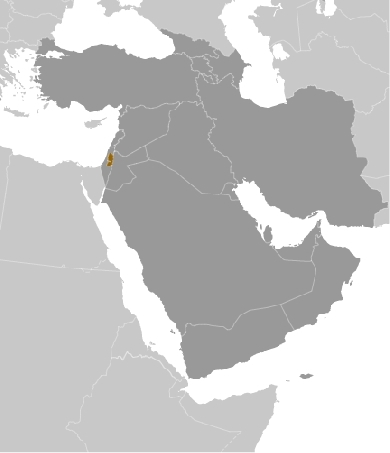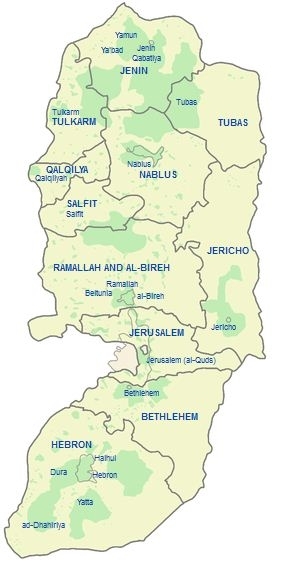West Bank
| Topics: |
Countries and Regions of the World Collection  The West Bank is a landlocked area in the Middle East, west of Jordan, east of Israel. It is one of two areas in the Palestinian Territories; the other area being the Gaza Strip.
The West Bank is a landlocked area in the Middle East, west of Jordan, east of Israel. It is one of two areas in the Palestinian Territories; the other area being the Gaza Strip.
It is home to over two-and-a-half million people. Nearly 300,000 Israeli settlers lived in the West Bank in 2009 and nearly 200,000 Israeli settlers lived in East Jerusalem in 2008/
Its major environmental issues include:
- adequacy of freshwater supply; and.
- sewage treatment
It the southeast, uit borders the Dead Sea. The highlands of the West Bank are the main recharge area for Israel's coastal aquifers.
|
Source: Wikimedia Commons |
The September 1993 Israel-PLO Declaration of Principles on Interim Self-Government Arrangements provided for a transitional period of Palestinian self-rule in the West Bank and the Gaza Strip.
Under a series of agreements signed between May 1994 and September 1999, Israel transferred to the Palestinian Authority (PA) security and civilian responsibility for many Palestinian-populated areas of the West Bank and Gaza Strip.
Negotiations to determine the permanent status of the West Bank and Gaza Strip stalled following the outbreak of an intifada in September 2000.
In April 2003, the Quartet (US, EU, UN, and Russia) presented a roadmap to a final settlement of the conflict by 2005 based on reciprocal steps by the two parties leading to two states, Israel and a democratic Palestine.
Following Palestinian leader Yasir Arafat's death in late 2004, Mahmud Abbas was elected Palestinian Authority (PA) president in January 2005. A month later, Israel and the PA agreed to the Sharm el-Sheikh Commitments in an effort to move the peace process forward.
In September 2005, Israel unilaterally withdrew all of its settlers and soldiers and dismantled its military facilities in the Gaza Strip and withdrew settlers and redeployed soldiers from four small northern West Bank settlements. Nonetheless, Israel still controls maritime, airspace, and other access to the Gaza Strip.
In January 2006, the Islamic Resistance Movement, Hamas, won control of the Palestinian Legislative Council (PLC). Hamas took control of the PA government in March 2006, but President Abbas had little success negotiating with Hamas to present a political platform acceptable to the international community so as to lift economic sanctions on Palestinians.
Violent clashes between Fatah and Hamas supporters in the Gaza Strip in 2006 and early 2007 resulted in numerous Palestinian deaths and injuries.
In February 2007, Abbas and Hamas Political Bureau Chief Khalid Mishal signed the Mecca Agreement in Saudi Arabia that resulted in the formation of a Palestinian National Unity Government (NUG) headed by Hamas member Ismail Haniya. However, fighting continued in the Gaza Strip, and in June 2007, Hamas militants succeeded in a violent takeover of all military and governmental institutions in the Gaza Strip. Abbas that same month dismissed the NUG and through a series of presidential decrees formed a PA government in the West Bank led by independent Salam Fayyad.
Fatah and Hamas in May 2011, under the auspices of Egyptian-sponsored reconciliation negotiations, agreed to reunify the Palestinian territories, but the factions have struggled to finalize details on governing and security structures. The status quo remains with Hamas in control of the Gaza Strip and Abbas and the Fatah-dominated PA governing the West Bank.
Fayyad and his PA government continue to implement a series of security and economic reforms to improve conditions in the West Bank.
Abbas, who on behalf of the Palestinians in September submitted a UN membership application, has said he will not resume negotiations with current Israeli Prime Minister Binyamin Netanyahu until Israel halts all settlement activity in the West Bank and East Jerusalem.
There are about 355 Israeli civilian sites including about 145 small outpost communities in the West Bank and 32 sites in East Jerusalem (2010 est.)
The current status of the West Bank is subject to the Israeli-Palestinian Interim Agreement - permanent status to be determined through further negotiation.
Israel continues construction of a "seam line" separation barrier along parts of the Green Line and within the West Bank.
Since 1948, about 350 peacekeepers from the UN Truce Supervision Organization (UNTSO), headquartered in Jerusalem, monitor ceasefires, supervise armistice agreements, prevent isolated incidents from escalating, and assist other UN personnel in the region.
Geography
Location: Middle East, west of Jordan, east of Israel
Geographic Coordinates: 32 00 N, 35 15 E
Area: 5,860 sq km (land: 5,640 sq km; water: 220 sq km) Note: includes West Bank, Latrun Salient, and the northwest quarter of the Dead Sea, but excludes Mt. Scopus; East Jerusalem and Jerusalem No Man's Land are also included only as a means of depicting the entire area occupied by Israel in 1967
Land Boundaries: 404 km (Israel 307 km, Jordan 97 km)
Natural Hazards: droughts
Terrain: mostly rugged dissected upland, some vegetation in west, but barren in east. The highest point is Tall Asur (1,022 m) and the lowest point (Tall Asur 1,022 m).
Land Use:
arable land: 16.9%
permanent crops: 18.97%
other: 64.13% (2001)
Climate: temperate; temperature and precipitation vary with altitude, warm to hot summers, cool to mild winters
People and Society
Population: 2,622,544 (July 2012 est.). Note: approximately 311,100 Israeli settlers live in the West Bank (2010); approximately 186,929 Israeli settlers live in East Jerusalem (2010) (July 2011 est.)
Ethnic Groups: Palestinian Arab and other 83%, Jewish 17%
Age Structure:
0-14 years: 35.8% (male 471,908/female 447,816)
15-64 years: 60.5% (male 796,421/female 757,227)
65 years and over: 3.7% (male 39,546/female 55,637) (2011 est.)
Population Growth Rate: 2.097% (2011 est.)
Birthrate: 24.56 births/1,000 population (2011 est.)
Death Rate: 3.58 deaths/1,000 population (July 2011 est.)
Net Migration Rate: 0 migrant(s)/1,000 population (2011 est.)
Life Expectancy at Birth: 75.01 years
Total Fertility Rate: 3.05 children born/woman (2011 est.)
Languages: Arabic, Hebrew (spoken by Israeli settlers and many Palestinians), English (widely understood)
Literacy (age 15 and over can read and write): 92.4% (2004 est.
Urbanization: 72% of total population (2008) growing at an annual rate of change of 3.3% (2005-10 est.)
Agriculture
Agricultural products: olives, citrus fruit, vegetables; beef, dairy products
Irrigated Land: 180 sq km; note - includes Gaza Strip (2003)
Economy
The West Bank - the larger of the two areas comprising the Palestinian territories - experienced a high single-digit economic growth rate in 2010 as a result of inflows of donor aid, the Palestinian Authority's (PA) implementation of economic and security reforms, and the easing of some movement and access restrictions by the Israeli Government.
Nevertheless, overall standard-of-living measures remain near levels seen prior to the start of the second intifada in 2000. The almost decade-long downturn largely has been a result of Israeli closure policies - a steady increase in movement and access restrictions across the West Bank in response to Israeli security concerns which have disrupted labor and trade flows, industrial capacity, and basic commerce, both external and internal.
Since 2008, the PA under President Mahmoud Abbas and Prime Minister Salam Fayyad has implemented a largely successful campaign of institutional reforms that has contributed to increased security and economic performance, supported by more than $3 billion in direct foreign donor assistance to the PA's budget since 2007. An easing of some Israeli restrictions on West Bank movement and access since 2008 also has contributed to an uptick in retail activity in larger cities.
The biggest impediments to economic improvements in the West Bank remain Palestinians' lack of access to land and resources in Israeli-controlled areas, import and export restrictions, and a high-cost capital structure.
Absent robust private sector growth, the PA will continue to rely heavily on donor aid for its budgetary needs.
GDP: (Purchasing Power Parity): $12.79 billion (2009 est.)
GDP: (Official Exchange Rate): $6.641 billion (2008 est.)
GDP- per capita (PPP): $2,900 (2008 est.)
GDP- composition by sector:
agriculture: 3.7%
industry: 13.6%
services: 82.7% (includes Gaza Strip) (2011 est.)
Industries: small-scale manufacturing, quarrying, textiles, soap, olive-wood carvings, and mother-of-pearl souvenirs
Currency: New Israeli shekels (ILS)



